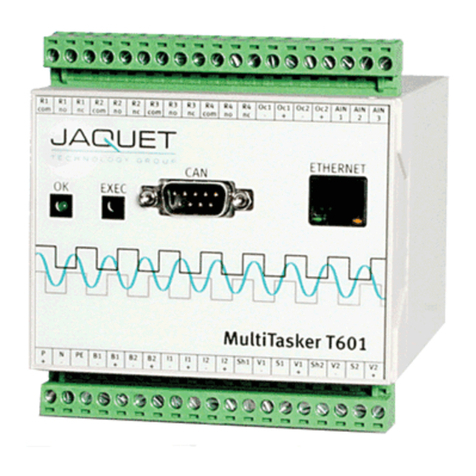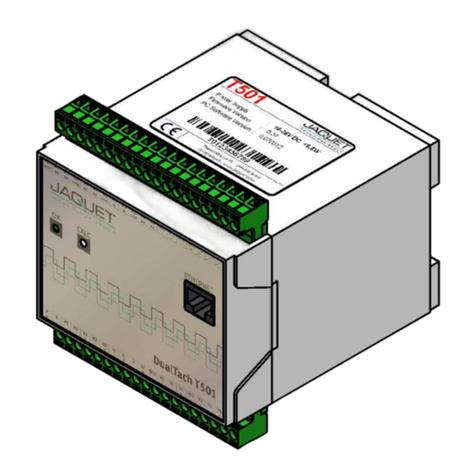Operating Instructions FT 3000JAQUET AG
377E-63917 Rev 4.00 page 3 of 47
7.7 TEST...................................................................................................................................................... 23
7.8 FREQUENCY OUTPUTS ........................................................................................................................... 23
7.9 LAMP TEST............................................................................................................................................. 24
7.10 MESSAGE ACKNOWLEDGEMENT............................................................................................................. 24
7.11 BINARY INPUTS ...................................................................................................................................... 24
7.12 PARAMETER ENTRY................................................................................................................................24
7.13 SIGNAL MONITORING.............................................................................................................................. 24
8 INSTALLATION.......................................................................................................................................... 26
8.1 GENERAL............................................................................................................................................... 26
8.2 IEC 61508-2-3 SPECIFIC INSTALLATION RULES..................................................................................... 26
9 SETTING PARAMETERS AND OPERATION......................................................................................... 27
9.1 SOFTWARE CONCEPT............................................................................................................................. 27
9.1.1 Process parameter list.............................................................................................................. 27
9.1.2 Configuration parameter list.................................................................................................... 27
9.1.3 Service parameter list............................................................................................................... 29
9.2 PC COMMUNICATIONS............................................................................................................................ 29
9.2.1 PC system requirements.......................................................................................................... 29
9.2.2 PC software installation............................................................................................................ 29
9.2.3 Optimisation...............................................................................................................................30
9.2.4 Setting the display interval....................................................................................................... 30
9.2.5 Protection of configuration parameters................................................................................. 30
9.2.6 Protection of process parameters .......................................................................................... 30
9.2.7 Reading and writing parameters............................................................................................. 30
9.2.8 Parameter printout..................................................................................................................... 30
9.2.9 Display of current measured data........................................................................................... 30
9.3 SETTING PARAMETERS........................................................................................................................... 31
9.3.1 System settings ......................................................................................................................... 31
9.3.2 Sensor monitor .......................................................................................................................... 32
9.3.3 Analog outputs........................................................................................................................... 32
9.3.4 Limit values................................................................................................................................. 32
9.3.5 Test values.................................................................................................................................. 33
9.3.6 Parameter enable....................................................................................................................... 33
9.3.7 Password .................................................................................................................................... 33
9.4 OPERATING BEHAVIOUR......................................................................................................................... 33
9.4.1 Power up..................................................................................................................................... 33
9.4.2 Measurements............................................................................................................................ 34
9.4.3 Response to sensor failure...................................................................................................... 34
9.4.4 Behaviour during system alarm.............................................................................................. 34
9.4.5 Response to mains failure........................................................................................................ 34
9.5 FREQUENCY MEASUREMENT CALIBRATION ............................................................................................. 34
9.5.1 Calibration tools......................................................................................................................... 35
9.5.2 Factors influencing accuracy .................................................................................................. 35
9.5.3 Calibration rules......................................................................................................................... 35
9.6 CALIBRATING THE SENSOR MONITOR...................................................................................................... 36
9.6.1 Factors influencing accuracy .................................................................................................. 36
9.6.2 Calibration rules......................................................................................................................... 36
10 MECHANICAL CONSTRUCTION......................................................................................................... 37
11 CIRCUIT DESCRIPTION........................................................................................................................ 39
11.1 FTFU 3024 MOTHERBOARD AND INPUT CARD....................................................................................... 39
11.1.1 Frequency measurement.......................................................................................................... 39
11.1.2 Speed monitors.......................................................................................................................... 39
11.1.3 Micro controller.......................................................................................................................... 39
11.1.4 Supply.......................................................................................................................................... 39
11.1.5 Reset and non-maskable interrupt (NMI)............................................................................... 40
11.1.6 Input amplifier ............................................................................................................................ 40
11.1.7 Sensor monitoring..................................................................................................................... 40
11.1.8 Module monitoring .................................................................................................................... 41
11.1.9 Relay outputs ............................................................................................................................. 41
































